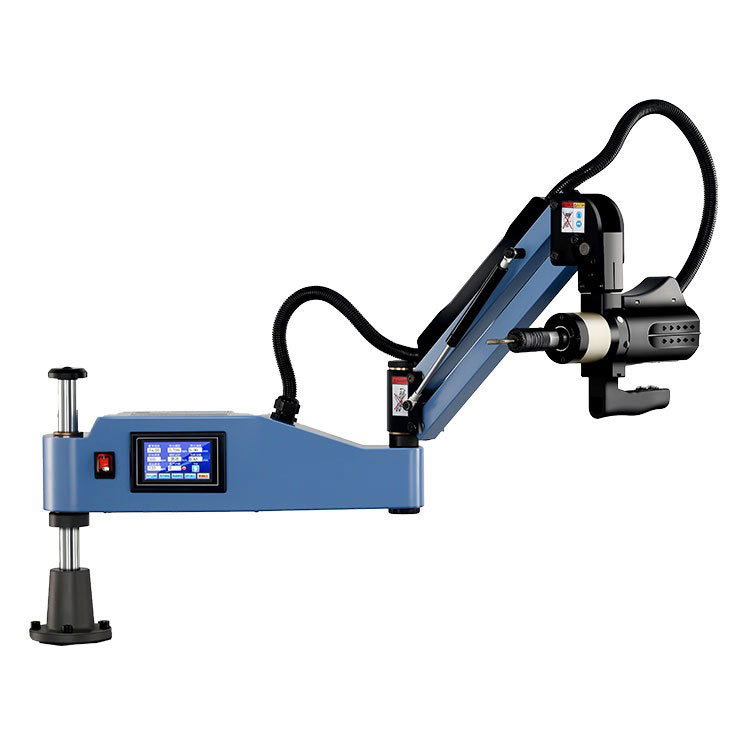Applications of CNC Electric Tapping Machines
2024-05-31
A CNC (Computer Numerical Control) electric tapping machine is a precision machining tool used for creating threaded holes in metal or plastic workpieces. It utilizes CNC technology to automate the tapping process, ensuring accuracy, repeatability, and efficiency. Here's an overview of the CNC electric tapping machine:
Characteristics:
1. CNC Control: Equipped with a computerized control system that allows for precise control of the tapping operation. CNC technology enables automated tool movements, speed adjustments, and thread depth control.
2. Electric Drive: Powered by an electric motor, providing consistent and reliable tapping performance. Electric drive systems offer high torque at low speeds, ideal for threading operations.
3. Tooling: Utilizes tapping tools such as tap holders, taps, and collets designed for CNC machining. These tools are selected based on the thread size, material type, and desired thread depth.
4. Workholding: Features a workholding system to secure the workpiece during tapping operations. This can include clamps, vises, or specialized fixtures tailored to the specific workpiece geometry.
5. Coolant System: Some CNC electric tapping machines are equipped with coolant systems to lubricate and cool the tapping tool during operation, prolonging tool life and improving surface finish.
Functionality:
1. Programming: Tapping operations are programmed using CNC software, specifying parameters such as thread size, pitch, depth, and tapping speed.
2. Tool Setup: The appropriate tapping tool is installed in the machine's spindle and secured using the toolholder. Tool lengths and offsets are measured and entered into the CNC control system.
3. Workpiece Setup: The workpiece is securely mounted on the machine's worktable or fixture, ensuring proper alignment and stability during tapping.
4. Execution: The CNC control system executes the programmed tapping operation, controlling the spindle speed, feed rate, and tool movement to create precise threaded holes in the workpiece.
5. Quality Control: Machined threads are inspected using thread gauges or other measuring instruments to ensure they meet specified tolerances and quality standards.
Applications:
1. Manufacturing: Used in various industries for the production of parts and components requiring threaded holes, including automotive, aerospace, electronics, and machinery manufacturing.
2. Prototyping: CNC electric tapping machines are valuable tools for rapid prototyping and product development, allowing for quick iteration and testing of threaded designs.
3. Maintenance and Repair: Employed for repairing or rethreading existing holes in components, machinery, and equipment.
4. High-Volume Production: Ideal for high-volume production environments where efficiency, accuracy, and consistency are critical.
Advantages:
1. Accuracy: CNC control ensures precise thread dimensions and pitch accuracy, meeting tight tolerance requirements.
2. Efficiency: Automation of the tapping process reduces cycle times and increases productivity compared to manual tapping methods.
3. Flexibility: CNC programming allows for easy adjustment of thread parameters and rapid setup changes for different workpieces.
4. Quality: Consistent tooling and machining parameters result in high-quality threads with uniform surface finish and integrity.
Considerations:
1. Programming Skills: Operators must be proficient in CNC programming and operation to effectively utilize the machine's capabilities.
2. Tool Selection: Proper selection and maintenance of tapping tools are essential for achieving optimal performance and prolonging tool life.
3. Workpiece Material: Consideration should be given to the type of material being tapped, as harder materials may require specialized tooling and machining strategies.
Conclusion:
CNC electric tapping machines are essential tools in modern manufacturing environments, providing efficient, accurate, and reliable threading solutions for a wide range of applications. With their advanced CNC control systems and electric drive technology, these machines offer precision, flexibility, and productivity advantages over traditional tapping methods. Proper setup, programming, and maintenance are key to maximizing the performance and longevity of CNC electric tapping machines in various machining operations.



